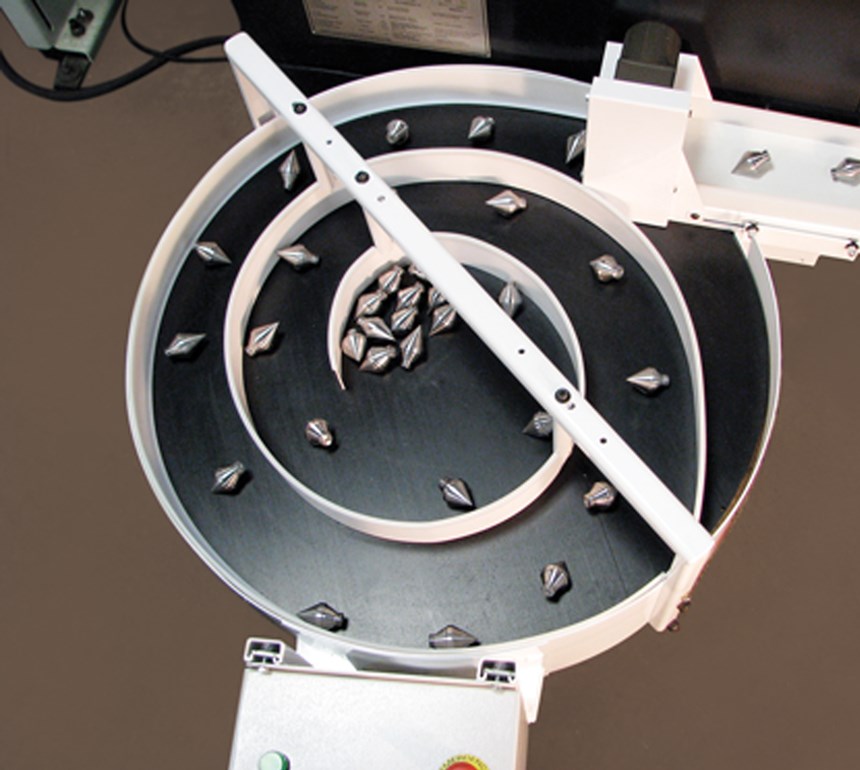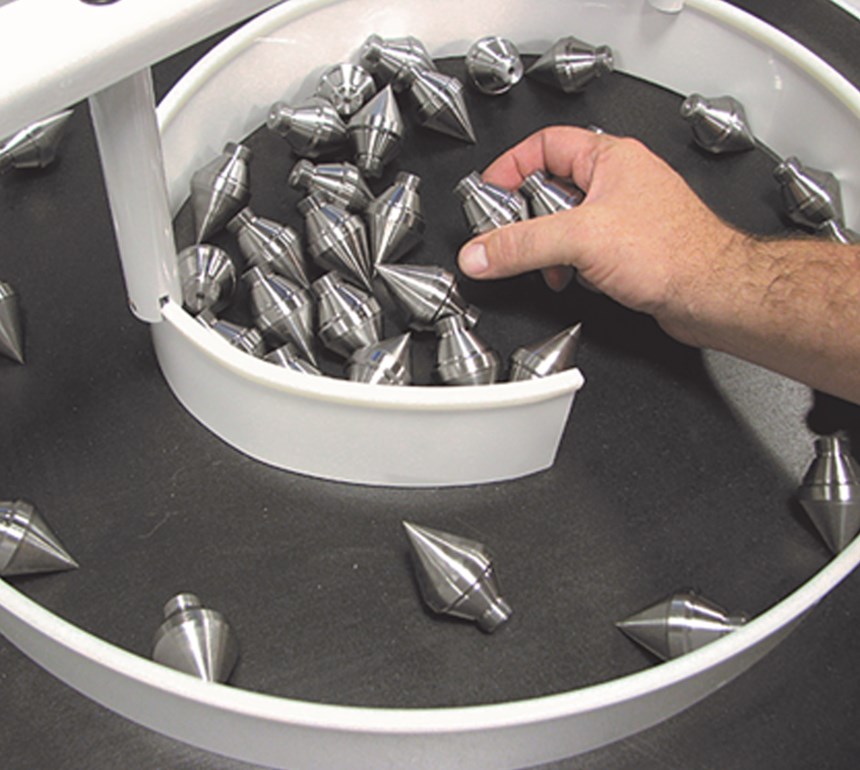Increase Throughput with Off-the-Shelf Automation
This automated parts accumulator is designed to complement any bar-fed CNC lathe, providing hours of profitable, unattended operation by safely collecting and organizing finished parts.
In today’s highly competitive market, business owners always are looking for ways to increase efficiency and productivity. On the shop floor, the answers may lie in continued training of personnel, more advanced machine tools or further refining of the production process. Additional automation technology is often considered to help a shop in these areas.
Resource Allocation
One product that has the potential to make a quick difference on the shop floor is the Rota-Rack from Royal Products. This automated parts accumulator is designed to complement any bar-fed CNC lathe, providing hours of profitable, unattended operation by safely collecting and organizing finished parts.
Historically, parts coming off of a CNC lathe are collected in a box or bin with limited capacity and no protection against damaging collisions. Sometimes, a bucket of oil or water may be used to reduce impact as the parts are dropped, but this method tends to be messy and could create potential health hazards. Rota-Rack solves these problems in a clean and efficient way and can significantly improve output with existing machines and employees.
By simply adding the parts accumulator to the existing machine tool, shops can maintain continuous operation and eliminate the need for a person to tend the machine and separate or manage parts. The unit separates the parts and keeps them ordered and free from dings without any user input. By safely delivering parts, it allows a shop to allocate employee talent to other tasks that can help to increase the company’s bottom line.
How it Works
Prior to the start of a job, the machine operator enters the part cycle time and degree of turntable rotation via a touchscreen programmable logic controller (PLC). A counter can also be set to automatically shut the Rota-Rack down at the end of a production run. Entering these three parameters takes only a few seconds, and then the parts accumulator is ready to go to work.
During most of the machining cycle, the unit remains motionless. But when a finished part comes out of the lathe, the conveyor starts up and moves the part toward the turntable. Each time a part comes out of the machine, the turntable indexes to the next position (the degree of turntable rotation is easily adjusted according to part length). The Rota-Rack will accommodate parts as much as 3 inches in diameter and 10 inches long. With some minor customization, it can handle even large parts.
As the turntable indexes, the parts are gently advanced toward its center via the fixed spiral guides. After several hours of unmanned production, finished parts are removed from the center of the turntable. The system helps increase profits by enhancing production, providing better part quality and maintaining streamlined use of the machines and employees. According to the company, the unit can pay for itself within a few months by running machines unattended, protecting parts from damaging collisions and reassigning personnel for maximum efficiency.
Quick Installation
The Royal Rota-Rack may be considered off-the-shelf automation because of the simplicity of installation and setup. It can often be up and running within an hour of unpacking it from the shipping crate. The unit ships with its height and orientation preconfigured according to customer specifications. Because it does not need to connect to the lathe either physically or electrically, installation only involves attaching the legs, sliding it into place in front of the machine and plugging it into a standard 110-volt outlet. The one additional step that may be required for some installations is the modification of the lathe’s part collection box, usually located on the door of the machine—for parts to reach the unit or its conveyor, the bottom and side of the box may need to be opened.
The Rota-Rack’s universal design makes it adaptable to virtually all CNC lathes. It can be positioned either to the left or right side of the machine and can rotate either clockwise or counter-clockwise. It is height adjustable from 10.5 inches to 53 inches (other height requirements can be accommodated upon special request). The unit is completely free-standing, so no bolting to the machine or floor is required. The control box can be positioned anywhere on the circumference for optimal clearance. The parts accumulator can be adapted to machines with existing conveyors, or an optional conveyor with an integral coolant collector can be added.
At 450 pounds, the system is built for harsh production environments. Its heavy gauge-welded steel frame supports as much as 700 pounds of finished parts. The surface area of more than 850 square inches provides a large capacity. To protect finished parts from scuffs and dents, all contact surfaces are covered in ultra-high molecular weight plastic. The spiral design of the accumulation process also helps to keep parts in sequential order for inspection and quality control purposes.
With the Rota-Rack, a shop can increase its production without increasing labor costs, save money and improve product quality by minimizing workpiece damage, scrap and expensive rework costs. It provides a shop with the flexibility to take on additional work without a costly machine tool investment.
Related Content
Starting Small with Automation
Quick-change workholding and flexible robotic automation started this small shop on the path to success.
Read MoreReplace Repetitive Measurement With DIY Robotic Automation
After minimal training, a shop can learn how to use this robotic inspection system configured for a shopfloor application to supersede repetitive, time-consuming, high-mix gaging processes. It can then be redeployed for another application somewhere else in the facility.
Read MoreZoller Event Shines Lights on Shopfloor Connectivity
The company’s open house event highlighted smart manufacturing solutions from CAM to part.
Read More4 Bright Ideas for Effective Lights-Out Machining
Adopting lights-out machining involves considerations when a machine shop decides to move forward with the process. Here are some tips to a successful implementation.
Read MoreRead Next
A Tooling Workshop Worth a Visit
Marubeni Citizen-Cincom’s tooling and accessory workshop offers a chance to learn more about ancillary devices that can boost machining efficiency and capability.
Read MoreDo You Have Single Points of Failure?
Plans need to be in place before a catastrophic event occurs.
Read MoreEmerging Leaders Nominations Now Open
Here’s your chance to highlight a young person in your manufacturing business who is on the path to be a future leader moving your company forward.
Read More












.jpg;maxWidth=300;quality=90)












